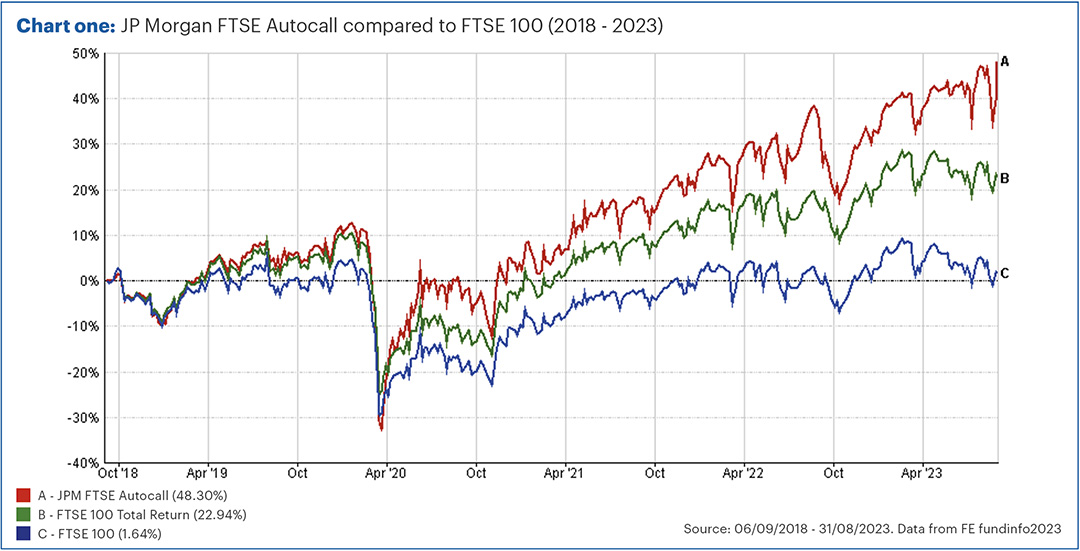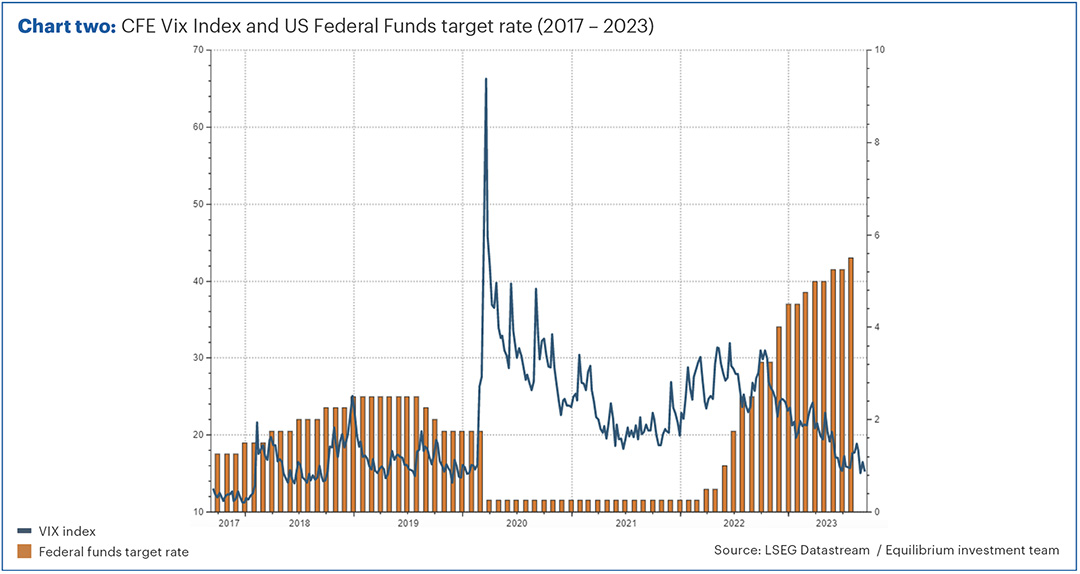Executive summary
- Risk and return are highly correlated. Our goal is to reduce the uncertainty within portfolios as much as possible without giving up potential returns.
- Defined returns products are a great way of doing this, giving us equity-like returns with a greater degree of certainty and some downside protection.
- The recent JP Morgan defined returns did a great job in portfolios, returning more than double the FTSE 100 Index to which it was linked.
- We have just struck two new defined returns products. The first offers a potential return of 10.25% p.a., based solely on the FTSE 100.
- The second product is based on both the FTSE 100 and the S&P 500 and could potentially yield an 11.9% annual return.
- We believe these options compare favourably to traditional equities, particularly given signs of a slowing economy and an increasing risk of at least a mild recession.
The uncertainty principle
In the investment world, risk and return are highly correlated.
Another word for risk is uncertainty. The returns you might receive on equity are much more uncertain than the returns you might receive on cash, for example.
With cash, you can generally predict the return you’ll receive in advance. Depending on the type of account you choose, you can expect mid-single digit returns on cash over the next 12 months.
However, in the stock market, returns could realistically range from +20% or -10% over the next 12 months, or even fall outside of this range.
We can attempt to reduce this uncertainty somewhat by examining valuation metrics, such as price/earnings ratios. For instance, we can analyse past returns when we’ve encountered similar valuation levels.
This data shows we’ve typically received in the region of 10% p.a. from a diverse mix of equities over the long term (5 to 10 years) when valuations have been at similar levels in the past (Source: Equilibrium Investment Management / LESG Eikon – Long term investment assumptions 2023). Sometimes it has been higher (closer to 15% p.a.), and sometimes lower (around 5% p.a.).
Valuations can provide an indication of long-term returns but are next to useless for predicting short-term market movements. An expensive market can get more expensive, while a cheap market can become even cheaper!
Valuations are also the reason why we see a correlation between risk and return. When risks are perceived to be higher, stock prices tend to be lower, resulting in higher valuations (and potential future returns).
As portfolio managers, one of our responsibilities is to mitigate this uncertainty.
For this reason, we are currently increasing our allocation to bonds, because they are offering higher yields than they have in the past. Depending on the type of bond, we are often seeing high single digit yields (Source: Equilibrium Investment Management fixed interest portfolio/ LESG Eikon / the underlying fund managers).
While bond yields may be slightly lower than the potential long-term returns from equities, we believe there is a higher degree of certainty in achieving those returns.
We don’t aim to eliminate all uncertainty, as doing so would also eliminate potential returns. However, there are ways we can reduce uncertainty in our equity holdings, such as by using defined returns.
Defined returns
We have just struck (created) two new defined returns products in our portfolios.
This replaces one that recently matured. We also have two more that might mature in the near future, and we may well increase exposure beyond just replacing these.
To refresh your memory about how these products function, let’s look back at the JP Morgan product that recently matured.
This was struck on 6 September 2018. On that date, the FTSE 100 Index was at 7,318.
The product promised to pay 10.35% p.a. as long as the FTSE 100 was at or above this level on any of the first six anniversary dates. If not, then we would get our money back (unless the FTSE was 40% or more below its start level on the sixth anniversary).
For the first four years, the market was below 7,318 on each of the anniversary dates (even though it had been higher at times in between dates) and so had not “kicked out”.
As we approached 6 September, the market was hovering at around 7,400, only just above the kick out level.
Had it kicked out, the product would have been worth £1.5175 per share, representing a 51.75% gain (5 x 10.35%). However, if the kick out did not occur, there was a risk that it might only be worth £1 per share, should the market drop back in its final year.
We therefore sold the product slightly early, at £1.483, to mitigate this risk.
Chart one shows the return of this product compared to the FTSE 100 on which it is based.
The blue line shows the FTSE in price terms – it has gone up a mere 1.64% over the last five years.
However, add in dividends then you get the green line, which was up 22.94%.
Our product is the red line and produced more than double this at 48.30%.
Chart one: JP Morgan FTSE Autocall compared to FTSE 100 (2018 – 2023)

Hybrid theory
A defined return is essentially a hybrid between a bond and an equity.
Like a bond, it has a fixed time until maturity (although it can be “called” early like many bonds).
It also has a “coupon” or fixed rate of return.
However, unlike a bond, you receive either the coupon or the return of your capital only if the stock market achieves certain conditions.
The coupon you receive is determined by two factors when it is created: the underlying bond yield and the volatility of the stock market.
A key indicator of expected volatility in the stock market is called the “Vix”. Its real title is actually the CBOE S&P 500 Volatility Index. It has been called the “Fear Index” because the value rises when investors’ fears rise.
When the Vix is high (and risks are perceived to be high), we tend to get a higher coupon from a defined return, which compensates us for taking the extra risk. When it is lower, risk is expected to be low, and we generally only get a lower rate of return.
The blue line on Chart two shows how this index has moved over time. Some clients may recall that during the pandemic, we were able to strike a defined returns product with a 20% headline rate. This coincides with the big spike in the blue line that you can see on the chart.
Chart two: CFE Vix Index and US Federal Funds target rate (2017 – 2023)

At the moment, the Vix – and therefore the perceived risk – is low, which normally wouldn’t make defined returns attractive.However, the orange bars on Chart two show interest rates (we’re looking at US rates as we’re showing US stock market risk). This can be read on the right-hand scale.
Because interest rates are at relative highs, bond yields are also higher. This means the bond part of the defined return is making up a greater proportion of the overall return. Despite the low equity risk premium, we are therefore still seeing some decent returns on these products.
For example, we have recently struck a new FTSE-related product that will pay 10.25% p.a. provided the market doesn’t fall over five years.
This also has a slightly different feature, where after the first year it can potentially kick out on the half-year as well as full-year anniversaries, pretty much doubling the number of kick out chances. This somewhat reduces one of the risks of these products which is their “all or nothing” nature, where the market needs to be at the right level on one particular date.
We’ve also struck a second product which may provide an 11.9% return. This one needs both the FTSE 100 and S&P 500 not to have fallen over the next five years.
Coming back to my earlier point, our best guess for equity market returns is around 10% p.a. over the long term. At present, we think defined returns offer a slightly higher expected return, but with less uncertainty.
In essence, by using these hybrid equity-bond assets, we are “borrowing” some of the extra yield on bonds to increase the potential equity return.
Of course, the products are not without risk. The principle one in our view is “underperformance risk”. For example, if it turned out the market returned 15% rather than 10%, we’d still just get our 10.25% and 11.9% returns from these new defined returns.
We are also essentially lending money to investment banks, and in the unlikely event of those banks failing, we could potentially lose some or all of our money. While we believe this is highly unlikely, it still necessitates diversifying across several banks with relatively small holdings in each.
The economy has generally done better than expected this year, but we see some signs that growth is slowing. We think there is an increasing risk of a recession (hopefully a mild one) in the next six months or so.
Generally, a recession wouldn’t be great for stock markets in the short term. It might be better for bonds, and interest rates would often be cut in this scenario, making bonds more attractive.
By buying defined returns instead, we can mitigate some of these risks, as we only need markets to go sideways rather than up. We can also afford to be patient, knowing the products can run for five years.
This newsletter is intended as an information piece and does not constitute a solicitation of investment advice.
Past performance is for illustrative purposes only and cannot be guaranteed to apply in the future.
If you have any further questions, please don’t hesitate to contact us. If you’re a client you can reach us on 0161 486 2250 or by getting in touch with your usual Equilibrium contact. For all new enquiries please call 0161 383 3335.




